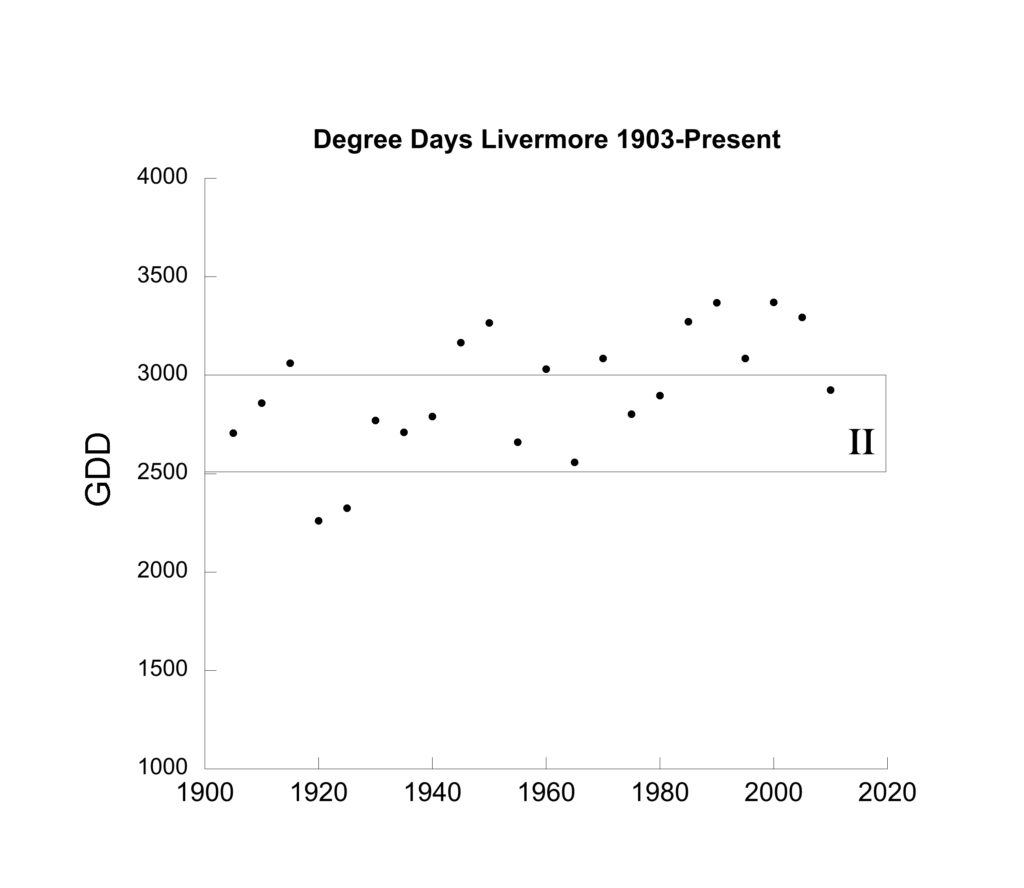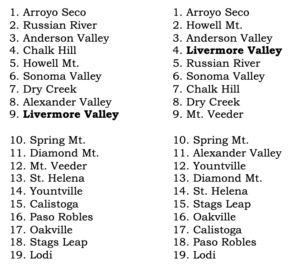Livermore’s Climate – We May be Cooler than you Think

Jon Bonné, the wine writer for the San Francisco Chronicle, recently opined (August 9, 2013) on the suitability of Livermore’s climate for growing grapes. Joining a chorus of others, like Steve Heimoff of Wine Enthusiast, Bonné contends we are a warm climate area best suited to varieties like Semillon and Zinfandel that can thrive in warm climates.
I have never been convinced that Livermore Valley can be described by a single climate zone. Our close proximity to the Bay with its cooling breezes every summer afternoon will give rise to microclimates – some cooler or warmer than others. On average, Livermore Valley is slow to ripen when compared with the Cabernet vineyards of Napa Valley.
So how warm are we? This notion of “hot” has framed discussion of our Valley for the last sixty years. The view that Livermore is a warm region originated in a single location measurement taken during the early 1940s by Winkler, data now known to be incomplete. The view of Livermore being “hot” is so strong that it has become canon, a view perpetuated by our winegrowing association, and guiding both viticulture and winemaking practices in much of the Valley.
For context, I have looked up median temperature data for a few well-known California appellations. I have ordered them from coolest (1) to warmest (19). The data are ordered according to both Growing Degree Days (GDD), and Biologically effective degree-days (BEDD). GDD, the classic Winkler scale, places Livermore Valley in the middle of these appellations, actually closer to Alexander Valley than Spring Mountain. What is most surprising is Livermore moves to position 4 when the data is corrected for diurnal temperature shifts (Gladstones developed these correction factors in 1992). Our Valley’s tremendous diurnal temperature swings create a growing climate between Anderson Valley and Russian River. This is almost unbelievable, yet it explains much about our Valley’s success with the Bordeaux varietals a century ago – especially Cabernet Franc, Cabernet Sauvignon, Merlot, and Sauvignon Blanc.
DATA FROM Gregory V. Jones, et al., “Spatial Analysis of Climate in Winegrape Growing Regions in the Western United States,” Am J Enol Vitic 61:313-326 (2010).
As further evidence, I analyzed daily temperature data from the National Weather Bureau from Livermore Valley from the early 1900s to present. From these, I was able to determine the Degree Growing Days over the past century. On average, despite urbanization, Livermore Valley is a region II to cold region III in the Winkler classification, ideal for the Bordeaux varietals and, in the warmer locations, for Rhone wines as well.

Jones, in the above mentioned article, also looks at the microclimates in major growing regions, including Livermore Valley, using spatially resolved data. No surprise here, Livermore Valley is one of the most diverse growing regions. In Biologically Effective Degree Growing Days (BEDD), Livermore ranges from 1308 – 1746 BEDD. To place this in perspective, Bordeaux averages 1382, the Rhone 1447, Rioja 1344, and Carneros 1749.
The actual data puts the question of Livermore’s climate to rest. No one climate describes our region, just as no single variety can be called signature. We should celebrate in our diversity!



